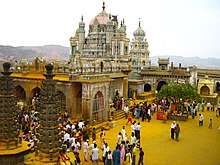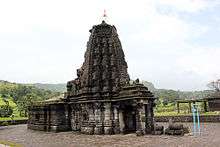Jejuri
Jejuri is a city and a municipal council in Pune district in the Indian state of Maharashtra. It is famous for the main temple of Lord Khandoba. It is a famous temple town being the family deity of many houses in Maharashtra and Karnataka. Its economy is centered on businesses catering to the numerous devotees coming to worship the Khandoba Temple there. Recently the increase in property rates and the planning of an international airport near the town has seen a spurt of development happening there.
Jejuri Jejurigad | |
|---|---|
 Devotees during a festival at Khandoba Temple of Jejuri | |
| Nickname(s): Khandobachi Jejuri | |
 Jejuri Location in Maharashtra, India | |
| Coordinates: 18.28°N 74.17°E | |
| Country | India |
| State | Maharashtra |
| Pune District | Tehsil Purandar, Pune |
| Government | |
| • Type | Municipal Council |
| Elevation | 718 m (2,356 ft) |
| Population (2001) | |
| • Total | 12,000 |
| Demonym(s) | Jejurikar |
| Official | |
| • Language | Marathi |
| Time zone | UTC+5:30 (IST) |
| PIN | 412303 |
| Telephone code | +91-2115 |
| Vehicle registration | MH-12,MH-14,MH-42 |
Naik Hari Makaji And Tatya Makaji Of Jejuri
Naik Hari Makaji and Naik Tatya Makaji were two Koli brothers and revolutionaries from Maharashtra. They revolted against British Hukumat. Naik Hari Makaji and Naik Tatya Makaji with Naik Rama Krishna of kalambi made an army of Ramoshis of Satara and revolted. In 1879 they raided in Poona fifteen times with ramoshi army. After that Hari Makaji and Tatya Makaji raided satara many time. In February 1879, Naik Hari Makaji attacked in Baramati portion of Bhimthadi. On the 8Th raid in Baramati, Naik Hari Makaji was attacked by British police but he escaped by fighting hand to hand with two British policemen and wounded them but two Ramoshis were captured. After that, at the beginning of March, Naik Hari Makaji again raised and revolted in Indapur and raided. But in middle of March, Hari was captured in Solapur. After capture of Naik Hari Makaji, His brother Naik Tatya Makaji led his revolution, Tatya Makaji continued till the end of the year. Naik Tatya Makaji raided the villages on the Purandar and Sinhagad ranges. On 17 October, Koli Naik Tatya Makaji and some of his followers killed a Ramoshi who was informer for British Major Wise. After that Tatya Makaji Naik brought to justice.[1][2][3][4][5][6][7][8][9]
Geography
Jejuri is located at 18.28°N 74.17°E.[10] It has an average elevation of 718 metres (2355 feet) mean sea level.
Demographics
As of 2011 India census,[11] Jejuri had a population of 14,515. Males constitute 51% of the population and females 49%. Jejuri has an average literacy rate of 73%, higher than the national average of 59.5%: male literacy is 79%, and female literacy is 67%. In Jejuri, 14% of the population is under 6 years of age.
Khandoba Temple
Jejuri Temple is located in the Jejuri town, which lies to the southeast of the Pune city of Maharashtra. The town is known for being the venue of one of the revered temples in the state, known as the Khandobachi Jejuri.[12] The temple is dedicated to Khandoba, also known as Mhalsakant or Malhari Martand or Mylaralinga. Khandoba is regarded as the 'God of Jejuri' and is held in great reverence by the Dhangars. The temple was the site of a historic treaty between Tarabai and Balaji Bajirao on 14 September 1752.[13]
Jejuri Khandoba Temple can be easily divided into two separate sections - the Mandap and Garbhagriha.
Lime mineral
Jejuri has Lime (mineral) deposits. The historic Shaniwar Wada fort at the central seat of Maratha Empire at Pune was completed in 1732 by the famed Peshwa Bajirao I, at a total cost of Rs. 16,110, from the Lime (mineral) mined from the lime-belts of Jejuri.
Gallery
 On the way to Jejurigad. Notice the stairs to temple and arches on the stairs
On the way to Jejurigad. Notice the stairs to temple and arches on the stairs Looking down the stairs, through one arch
Looking down the stairs, through one arch Holy flame in front of the temple
Holy flame in front of the temple Deepstambha in front of the temple
Deepstambha in front of the temple
See also
References
- Gazetteer of the Bombay Presidency: Poona (3 pts.). Government Central Press. 1885.
- Gazetteer of the Bombay Presidency: Poona (2 pts.). Government Central Press. 1885.
- 77 (1880). REPORT ON THE ADMINISTRATION OF THE BOMBAY PRESIDENCY.CS1 maint: numeric names: authors list (link)
- Sunthankar, B. R. (1993). Nineteenth century history of Maharashtra. Shubhada-Saraswat Prakashan.
- Majumdar, Ramesh Chandra (1951). The History and Culture of the Indian People. G. Allen 8 Unwin.
- Gazetteer of the Bombay Presidency: Poona. Printed at the Government Central Press. 1885.
- Gazetteer of the Bombay Presidency: Poona (3 pts.). Government Central Press. 1885.
- State), Bombay (India (1885). Gazetteer. Government Central Press.
- "ऐतिहासिक". jejuri.in. Retrieved 1 January 2019.
- Falling Rain Genomics, Inc - Jejuri
- "Census of India 2001: Data from the 2001 Census, including cities, villages and towns (Provisional)". Census Commission of India. Archived from the original on 16 June 2004. Retrieved 1 November 2008.
- "Jejuri". Amazing Maharashtra.
- Eaton, Richard M (2005). A social history of the Deccan, 1300-1761: Eight Indian lives. Cambridge: Cambridge University Press.
Bibliography
| Wikimedia Commons has media related to Jejuri. |
- Günter-Dietz Sontheimer: Some Incidents in the History of the Khandoba. In: Asie du Sud. Traditions et changements. VIth European Conference on Modern South Asian Studies 1973. Hrsg. von M. Gaborieau u. A. Thorner, Paris 1979, S. 11-117.


